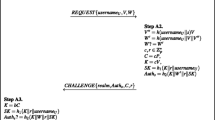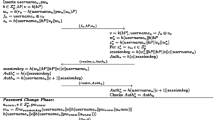Abstract
The session initiation protocol (SIP) is the most widely used signaling protocol for controlling communication on the Internet, establishing, maintaining, and terminating the sessions. To get secure communication, many authentication protocols for SIP have been proposed. Very recently, Zhang et al. proposed a new authenticated key agreement protocol for SIP using smart card. They also show their protocol could withstand various attacks. However, in this paper, we point out that their protocol is vulnerable to the impersonation attack. We also propose an improved protocol to overcome the weakness. Security analysis shows that our protocol could overcome the weaknesses in Zhang et al.’s protocol. Performance analysis shows that the computational cost in the authentication phase of our protocol is about 75 % of Zhang et al.’s protocol.




Similar content being viewed by others
References
Franks J, Hallam-Baker PM, Hostetler JL, Lawrence SD, Leach PJ, Luotonen A, Stewart LC (1999) HTTP authentication: basic and digest access authentication. Internet RFC2617
Yang C, Wang R, Liu W (2005) Secure authentication scheme for session initiation protocol. Comput Secur 24:381–386
Huang H, Wei W, Brown G (2006) A new efficient authentication scheme for session initiation protocol. Proc JCIS(06)
Jo H, Lee Y, Kim M, Kim S, Won D (2009) Off-line password-guessing attack to Yang’s and Huang’s authentication schemes for session initiation protocol. Proc INC, IMS IDC 618–621
Durlanik A, Sogukpinar I (2005) SIP authentication scheme using ECDH. World Enformatika Soc Trans Eng Comput Technol 8:350–353
Wu L, Zhang Y, Wang F (2009) A new provably secure authentication and key agreement protocol for SIP using ECC. Comput Stand Interfaces 31:286–291
Yoon EJ, Yoo KY et al (2010) A secure and efficient SIP authentication scheme for converged VoIP networks. Comput Commun 33:1674–1681
Pu Q (2010) Weaknesses of SIP authentication scheme for converged VoIP networks. IACR Cryptol ePrint Arch 2010(464)
Gokhroo MK, Jaidhar CD (2011) Tomar AS cryptanalysis of SIP secure and efficient authentication scheme. Proc ICCSN 2011:308–310
Tsai JL (2009) Efficient nonce-based authentication scheme for session initiation protocol. Int J Netw Secur 9:12–16
Yoon E, Shin Y, Jeon I, Yoo K (2010) Robust mutual authentication with a key agreement scheme for the session initiation protocol. IETE Tech Rev 27:203–213
Xie Q (2012) A new authenticated key agreement for session initiation protocol. Int J Commun Syst 25:47–54
Arshad R, Ikram N (2013) Elliptic curve cryptography based mutual authentication scheme for session initation protocol. Multimedia Tools Appl 66(2):165–178
He D, Chen J, Chen Y (2012) A secure mutual authentication scheme for session initiation protocol using elliptic curve cryptography. Secur Commun Networks 5(12):1423–1429
Zhang L, Tang S, Cai Z (2013) Efficient and flexible password authenticated key agreement for Voice over Internet Protocol Session Initiation Protocol using smart card. Int J Commun Syst. doi:10.1002/dac.2499
Kocher P, Jaffe J, Jun B (1999) Differential power analysis, Proceedings of Crypto ‘99, pp. 388–397, Springer-Verlag
Messerges TS, Dabbish EA, Sloan RH (2002) Examining smart-card security under the threat of power analysis attacks. IEEE Trans Comput 51(5):541–552
He D, Chen J, Hu J (2012) An ID-based client authentication with key agreement protocol for mobile client–server environment on ECC with provable security. Inform Fusion 13(3):223–230
He D, Wu S (2013) Security flaws in a smart card based authentication scheme for multi-server environment. Wirel Pers Commun 70(1):323–329
Zhang D, Ma Z, Niu X (2013) Anonymous authentication scheme of trusted mobile terminal under mobile internet. J China Univ Posts Telecommun 20(1):58–65
Pu Q, Wang J, Wu S (2013) Scalable and efficient mobile authentication scheme preserving user privacy. Int J Ad Hoc Ubiquit Comput 12(2):65–74
Acknowledgments
This work was supported by the National Research Foundation of Korea Grant funded by the Korean Government (NRF- 13S1A5B6044042).
Conflict of Interest
The author declares that he has no conflict of interest.
Author information
Authors and Affiliations
Corresponding author
Rights and permissions
About this article
Cite this article
Tu, H., Kumar, N., Chilamkurti, N. et al. An improved authentication protocol for session initiation protocol using smart card. Peer-to-Peer Netw. Appl. 8, 903–910 (2015). https://doi.org/10.1007/s12083-014-0248-4
Received:
Accepted:
Published:
Issue Date:
DOI: https://doi.org/10.1007/s12083-014-0248-4




